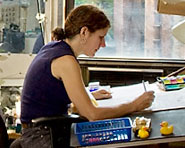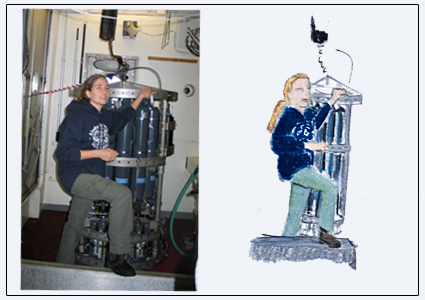You are here
Bringing Science and Art Together on the High Seas
09/08/08 Portland, Ore.
 View interview with Elise Engler and see samples of her artworkThe seas swelled to over 17 feet as the artist strapped down her baskets of pencils. This was the last day of an unordinary assignment. Elise Engler was heading home after drawing every piece of scientific equipment aboard a research ship.
View interview with Elise Engler and see samples of her artworkThe seas swelled to over 17 feet as the artist strapped down her baskets of pencils. This was the last day of an unordinary assignment. Elise Engler was heading home after drawing every piece of scientific equipment aboard a research ship.
How did this native New Yorker end up drawing a research cruise?
Engler was invited by the Center for Coastal Margin Observation and Prediction (CMOP) to draw a world most people don't know about, the world aboard a research cruise. “The idea was to learn what it means to be a research scientist on a vessel,” Engler says.
She joined the crew aboard the Research Vessel (R/V) Wecoma to draw the tools scientists used to collect water and sediment samples off the coast of Washington and Oregon. However, the drawings had a slight twist to them. All the objects would be drawn very small and highly detailed on a large scroll of paper.
Engler's artistic style takes apart a situation and reduces it to their components. This helps her to better understand the situation. For example, she once drew every piece of equipment on a fire truck. “I reveal the components to make the process more visible,” Engler says.
 A sample of Engler's artworkArmed with 11 baskets filled with 160 colored pencils, Engler drew each piece of scientific equipment aboard the Wecoma. She started with the CTD sensor, a large, complicated looking device that measures and collects water samples. She drew the niskin bottles, various tubes, measuring equipment and parts used on the CTD rosette.
A sample of Engler's artworkArmed with 11 baskets filled with 160 colored pencils, Engler drew each piece of scientific equipment aboard the Wecoma. She started with the CTD sensor, a large, complicated looking device that measures and collects water samples. She drew the niskin bottles, various tubes, measuring equipment and parts used on the CTD rosette.
Engler setup her drawing area in the dry lab. “This was handy because it was close to all the objects I was drawing,” Engler says. There she brought over the objects to draw. If the objects were too big to move, like the CTD, she would go over to it, take pictures, and make drawings. The photos helped as a reference guide, especially if the object had a complex amount of components and connections to draw.
Engler interacted with the scientists and technicians while aboard the ship. "They responded graciously, patiently and generously to my questions, explaining the functions of the objects I was drawing," Engler says. “I couldn't have drawn all these items accurately without being on the site.”
Engler is a visual and teaching artist in New York City. Her compartmentalized drawing style started when she decided to draw everything in her apartment. This was not to be traditional large-scale paintings but small icon size drawings. A year and a half later she created a pictographic inventory of her apartment. Today, she has drawn a variety of objects including the contents of virology lab and all the equipment used to maintain a New York City public city park. Her iconic artwork is the language she uses for communicating complex settings.
Engler is able to take what she learned aboard the research cruise and pass it on to the public. When her work is exhibited at galleries or to students, there are always lots of questions. What is that? What does it do? She is more than glad to tell them more about the drawings. Engler says, “I hope this experience helps bring science and art together.”
Written by Jeff Schilling






